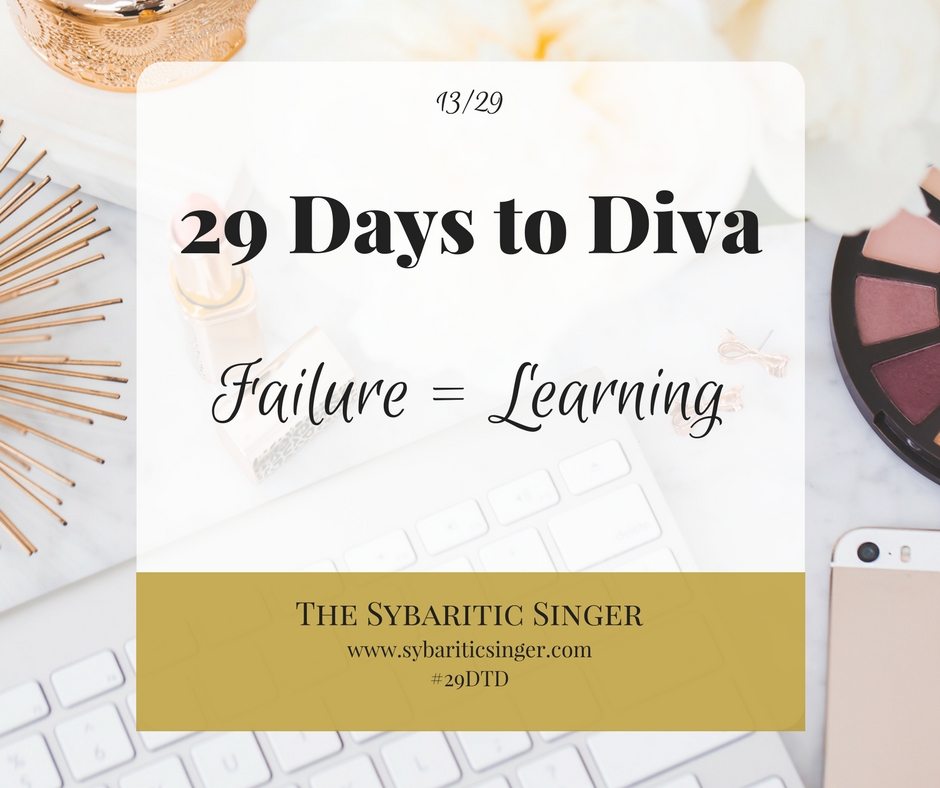“Success does not equal success. Success does not equal money. Failure of one option does not mean I’m personally failing. Failure equals learning. Failure equals learning. Failure equals learning,” our diva kept repeating to herself. It was difficult to remember these things when she was knee deep in a project and some of the elements were going sideways. She knew that the things she wanted would not just fall into her lap, but this felt so challenging.
She was scrambling. Her dreams kept coming back to water. First, she’d be bailing water out of her sinking canoe looking frantically around for someone to help her. Then, she’d be rushing to fill pails over and over only to realize that there were holes in the bottom of each one but she didn’t have anything to fix them. She’d wake up just as stressed out as she felt when she went to bed. Those nights of fitful sleep and the nagging pain in her gut was making itself apparent in her daily work.
The Day 13 challenge on your journey is to learn how to overcome failure.
Our diva had been experiencing some little frustrations, setbacks, and conflicts with her stated plans. Nothing major, thankfully. It was all going to happen. But, she couldn’t help but get mired in the things that weren’t working out the way that she saw them going in her head. “I always do this!” she cried out as she was driving to work. “I get so worked up about little tiny things instead of actually figuring out how to absorb these little annoyances and reversals and move forward!” The worst part is that it always felt like a surprise. Everything was moving along fine and then bam! It was her neck that told her that there were problems. Suddenly, her shoulders were up at her ears and she could feel tension radiating from her cervical vertebrae.
She reached her desk. As she settled in, she started rolling her shoulders back and forth trying to release some of the tension. “Would it be weird if I just got into down dog right here?” she pondered to herself smiling. Sipping her still piping hot coffee, she started realizing that maybe now wasn’t the right time to start doing yoga in her dress pants. But, she could alleviate some of this tension from the inside out. “I have got to start reconciling some of these frustrations and regain some perspective.” she thought.
How are you going to survive failure?
As felt like her standard protocol these days, a brand new sheet in her bullet journal awaited her. She started free-writing.
- How does this failure increase the stakes?
- This failure increases the stakes because I feel like I’m running out of time and I didn’t have that much to begin with. Every moment that I waste by losing people or changing the parameters of the project feels like it’s taking away from what I can accomplish.
- I need to practice not adding emotional weight to each little logistical element of this project. If someone says “no”, I don’t have to mourn that if I haven’t added emotional weight to that outcome in the first place. What if I just made a list of possible options and then strike some off the list when they don’t work and keep adding new ones that could?
- Detail what you might lose if you fail versus what you will lose if you don’t try. List five points for each option.
- I guess I could just stop. I could just thank Nick and say, “you know what? I’m not ready. Let’s try this another time.” I could do that. But, that feels like wasting this opportunity. I don’t want to waste this momentum and motivation that I feel for this project.
- What if this isn’t the right time? What if this is a great idea but for another time or another season? Hmmm… I might need to think on that more.
- Okay, okay, five points for each option:
- If I fail, I might lose credibility. I might lose motivation. I’ll definitely lose money. I’ll definitely lose some good will in my community. I think I’d probably lose self-respect. Hmmm, that’s five.
- If I don’t try, I would still lose self-respect. I would lose all the knowledge of how to pull this off. I would lose an opportunity to set myself apart even from the singer I was just last year. I may not lose money, but perhaps I’d lose this venue opportunity. I would lose this moment in which to create this work. I want to make this happen while people are talking about it.
- What are your options after each situation? After which experience are you in a stronger position?
- I’m definitely in a stronger position as a musician after I take this leap. I’d probably be in a stronger position financially if I just don’t do anything because then I could save my money. What if something important comes along while I’m doing this and then I won’t be able to accept that opportunity because I’ve already chosen this?
- At what point would you stop trying/move on?
- At which point, should I start to narrow my focus? At which point do I just stop trying to make this project happen and totally move on? I think I need to start narrowing my focus now. I need to focus on only a couple of collaborative partners rather than a huge complex team. I also need to maybe shorten the residency by one day. That would help me focus the activities and help pour more energy in resources into the fewer options rather than run myself ragged on all the various things I want to do. I can start to think of this as an ongoing thing. Where do I want my audience to start? That is going to be this residency. What is the primary goal? That can happen now. Then, start adding all other ideas into a new file for subsequent residencies.
- How are you going to survive failure?
- Cry?
- Eat a lot of ice cream?
- No, I’m going to start being more objective. Make notes of why things didn’t work out the way I thought they would at first. Those collaborators didn’t turn me down because they didn’t like the idea. They were either busy or needed to have remuneration for their work. Those are totally valid reasons. If I want these things to work in the future, I need to plan for that. I need to ask people to commit early and I need to compensate them for that commitment. Okay.
The equation for successful change
She started thinking about how she could make this process feel easier in the first place. She made a sudden connection that she was in the first state of that Columbia Business School equation for successful change. The equation goes something like D x V x P > C which is explained:
(Dissatisfaction with current state) x (Clear vision for change) x (Process for getting it done) > (Cost of change)
There needs to be dissatisfaction to induce change. Our diva clearly felt that right now. She knew that she wouldn’t change any part of this unless there was some pain point that made her try a different route. Otherwise, she’d be too comfortable. The whole reason she was exploring this new path is that she was uncomfortable with the old one, right? So, here she was. Dissatisfied is the first step to change. Next, she needed a clear vision. She was working on that all the time. She was creating lots of vision for what she wanted the next part of her career to look like. Then, that meant process. Successful change requires a step-by-step process. She needed to get her micro-actions in order. But, since this was all a new experiment for her, that step-by-step was going to need a lot of trial and error. She needed to remind herself that if she attached less emotional weight to the step-by-step then the trial and error aspect wouldn’t feel as frustrating. It would feel more like exploring! It would feel more empowering.
Making success happen; not avoiding failure
Our diva felt more inspired to work on making success happen rather than trying to avoid failure. She could begin to see how other entrepreneurs saw failing as a normal part of venturing. Because they are willing to fail, they often create portfolios or ventures, knowing and learning to kill one that’s going nowhere. Then, they could focus on and nurture other ideas as they became more viable. She liked how that felt. “Don’t make anything too precious,” she reminded herself.
She took a look at that last element of the equation: cost of change. She remembered, “the benefits of change must outweigh the costs and pains of change.” How will she know? “I guess I have to be okay with not knowing ahead of time if the benefits will outweigh the costs. Or, do I actually think that the learning process of following this new path is worth any pains of change?” she asked herself. Our diva wasn’t entirely sure. But, she remembered, “failure equals learning and I’d rather be learning.”
29 Days to Diva: The Worksheets
 Want some help completing your Day 13 challenge? 29 Days to Diva is all about tackling the big issues of our careers through micro-actions. What can you do today to move yourself closer to unlocking your artistic integrity or achieving your biggest goals and dreams? How do you handle failure? Can you prepare for some potential pitfalls? Today’s worksheet is a quick flowchart to help you figure out how to overcome obstacles in your project planning and execution.
Want some help completing your Day 13 challenge? 29 Days to Diva is all about tackling the big issues of our careers through micro-actions. What can you do today to move yourself closer to unlocking your artistic integrity or achieving your biggest goals and dreams? How do you handle failure? Can you prepare for some potential pitfalls? Today’s worksheet is a quick flowchart to help you figure out how to overcome obstacles in your project planning and execution.
Hey divas! I could really use your help. If you liked today’s post or any of the 29 Days to Diva posts so far in this series, will you please share it on your favorite social media channels? It would really help me out. Thanks! You can find me @mezzoihnen or feel free to use the hashtag #29DTD or #29DaystoDiva.

